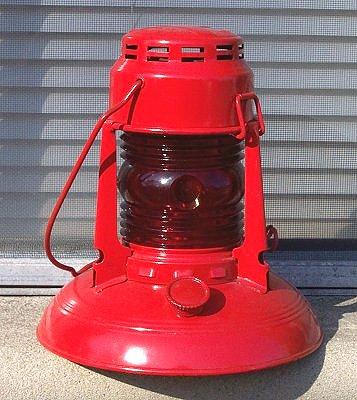Third Generation Model 40
The pressed steel latch is replaced with a simple wire "U" clip but operating in the same manner. The stylish curved finger bail has been replaced with a plain hand bail attached to opposite sides of the dome. The horizontal globe guard is completely gone.
A new burner uses a plain flat 3/16" wick. Most models [D3] have a standard wick-raiser. But others [D3H] have the raiser hidden within an upright.
While the transition from type 1 to type 2 was probably dramatic and inclusive the changes involved during the evolution of this lantern from a type 2 to type 3 were gradual and no doubt dependent upon parts and tooling available as noted in the Dietz introduction. Also some of the changes were possibly initiated by large custom orders that were significant enough to remain as the new standard.
- Perhaps the first change was the introduction of a new filler with different threads.
- Another of the first changes may have been the bail - the type 2 had undergone a change in the method of attachment probably due to lack of parts. The next logical step would have been to change from the finger bail to the hand bail. (The new hand bail is similar to if not exactly the same one Dietz provided on the Night Watch. )
- The uprights were probably modified at first just for one customer that wanted the keyed wick-raiser hidden in the larger upper hole - and once production started for that modification it just continued. (The double-base [D3CE] seems only to have been used by Con Ed.)
- And possibly next, to save costs, the horizontal globe gard wire was eliminated. (This has been confirmed - City of Milwaukee lanterns type 3 are known with the horizontal wire gard.) Latter type 3s do not have them.
- As tooling wore out it would seem logical at that point to change to the easily manufactured wire clip instead of the dome clamp.
Of course this is just a guess. The Traffic Gard lantern. Such a seemingly simple item but a reflection of our society's and our industrial and transportation revolution and evolution!
(R. Meyer photo)
